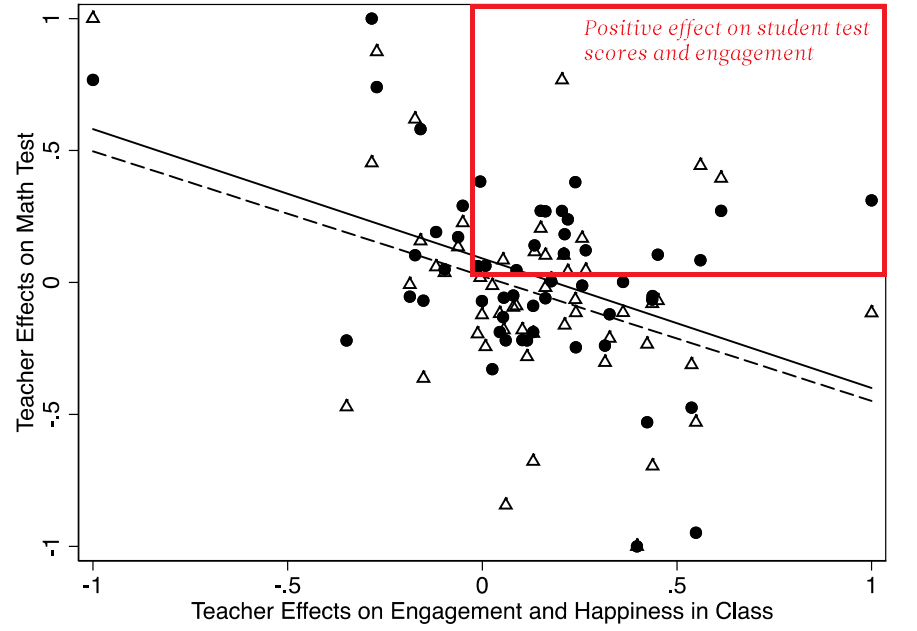Earlier this year,
a new working paper earned news coverage by suggesting that there is a “tradeoff” between teachers who are successful at raising student test scores and those who foster greater student engagement and happiness in class. While provocative, this suggestion is over-simplistic and ignores that many teachers are successful at both. What the research findings do support is that measuring what makes a teacher effective is a complicated endeavor, and since “good” teaching is so multifaceted, it requires multiple measures to capture its complexity.
The study, by David Blazar of the University of Maryland College Park and Cynthia Pollard of Brown University, used (pre-pandemic) National Center for Teacher Effectiveness (NCTE) data for 53 teachers and over 600 4th and 5th grade students in four East Coast school districts to compare the impact of teachers on their students’ achievement in math with student survey results reporting on “Engagement & Happiness in Class.” The big and surprising finding was a negative correlation between the two variables: a teacher whose students had higher math gains was more likely to have students report lower levels of engagement and happiness in class, and vice versa.
Blazar and Pollard dug into teacher survey data on instructional practice and teacher observation data from video-taped lessons to better understand why this might be happening. In what is surely a blow to math teachers everywhere, they found that the teachers whose students reported lower levels of engagement and happiness were also more likely to have more ambitious, cognitively-demanding, and error-free instruction in their math lessons.
So, what gives? Data from this study that connected these students’ 4th and 5th grade data to those same students’ high school math achievement and survey responses on their feelings about school and future goals found that both the test scores and engagement/happiness data were predictive of better high school outcomes. Other research, too, has found that non-test student outcomes, such as measures of how students perceive their
school climate, student attendance and grades, and teacher-student relationships have positive correlations with both test score gains and other academic and non-academic factors—from suspension rates to college attendance.
The bottom line is that a host of research finds “good” teaching, or teaching that contributes to greater learning and life outcomes for students, is both about raising test scores and supporting greater engagement and happiness in class. Rather than see this as a tradeoff, we need to focus on how to foster and measure
both. An accurate, reliable, and unbiased measure of teacher effectiveness can’t depend on just one input. Data from multiple classroom observations, student test scores, student surveys, and more can be brought together to create a more comprehensive picture of how a teacher supports their students’ success.
The good news is that Blazar and Pollard found plenty of evidence that many teachers indeed do both. The figure below, from
the working paper, shows the negative correlation, but also shows a number of teachers for whom there was no “tradeoff.” The researchers did conduct a very small (N=12) subsample analysis to compare practices of teachers who raised math test scores but had low levels of student engagement to those who raised test scores and achieved high levels of student engagement, but more research is needed, preferably in other subjects in addition to math, to really get at what drives these positive results for some teachers.
The study found many teachers who both successfully raised student test scores and fostered higher student engagement and happiness in class
| Adapted from: Figure 1. Correlations between Teachers’ Effects on Students’ Math Performance versus Engagement and Happiness in Class, Blazar, D. & Pollard, C. (2022). Authors’ note: Each circle or hollow triangle represents a teacher. Circles and the solid best-fit line represent the relationship between teachers’ effects on students’ Engagement and Happiness in Class and state math test scores; hollow triangles and the dashed best-fit line represent the relationship between teachers’ effects on students’ Engagement and Happiness in Class and project math test scores. |
More like this

How are districts observing and providing feedback to teachers?
Frequent observations and feedback can help teachers excel in the classroom.

Establishing positive teacher-student relationships may help boost student outcomes
New research explores the dynamic between teacher relationship skills and elementary student learning in math and literacy.

Seven ways to make improving teacher evaluation worth the work
A look at how using evidence-based practices can help ensure that teacher evaluation systems produce positive outcomes.


